|

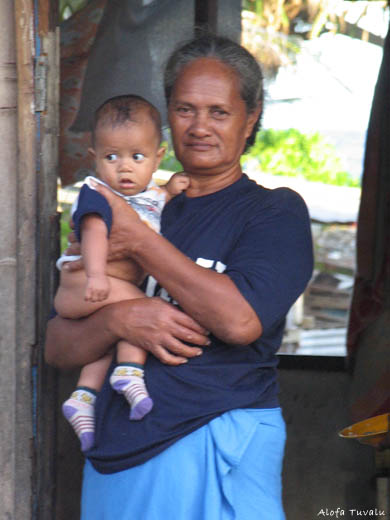 To instigate joint and simultaneous action amongst politicians, decision-makers, and citizens, in Tuvalu and elsewhere, we have chosen a positive approach using two concurrent strategies: To instigate joint and simultaneous action amongst politicians, decision-makers, and citizens, in Tuvalu and elsewhere, we have chosen a positive approach using two concurrent strategies:
1) a unifying and useful real-world project and
2) a widely disseminated information campaign based on the project.
The primary objective of Small is Beautiful: Assist the Tuvaluans to survive as a nation, and if possible, allow them to remain on their ancestral land. This can be achieved by a combination of:
- Reduction of greenhouse gas emissions and raising awareness of other sustainable development solutions and initiatives (using some of the tools of the Small is Beautiful project, participating in campaigns for the application of international directives and by changing individual habits through education)
- Study of appropriate on-site solutions for local environmental problems
- Plan for worst case scenario: identifying a new homeland where the nation of Tuvalu can be resettled, and establishment of an official status for environmental/climatic refugees.
The ultimate objective: participate in an active, global movement to create tools for safeguarding our environment and hopes of a solution for us all.
The means: a media campaign based on a positive, unifying and concrete program: Assisting Tuvalu, as its own destruction approaches, to become an environmental showcase - a living, breathing, replicable model of an environmentally respectful and exemplary nation – is a compelling means for Tuvalu to leave both a vital message and an important legacy to the world.

"Small is Beautiful" is one of the Unesco Education Decade for Sustainable Development Reparquable Actions
Tuvalu is symbolic on many levels: one of the smallest nations, it is among the first in line to face dramatic climate changes and is the nation the most respectful of Human Rights. The idea is to start from this tiny example to develop a program of constructive action –- one which is replicable and likely to garner the necessary media attention.
 Tuvalu, a tiny and extremely low-lying nation, is the epitome of vulnerability. It is also, due to its small size, recent habits of consumption, and traditional relationship with nature, a perfect candidate for becoming the first country to operate in harmony with the environment, an environmental showcase of the earth, a living ideal for the planet to emulate. A way for this new Atlantis to leave a positive mark on our planet. Tuvalu, a tiny and extremely low-lying nation, is the epitome of vulnerability. It is also, due to its small size, recent habits of consumption, and traditional relationship with nature, a perfect candidate for becoming the first country to operate in harmony with the environment, an environmental showcase of the earth, a living ideal for the planet to emulate. A way for this new Atlantis to leave a positive mark on our planet.
2 primary objectives need to be addressed on a global level:
- Creating a chain-reaction by initiating similar programs to follow the Tuvalu model. This will be done first through regular media communication about what is actually happening in Tuvalu, then by emulating the methods used on Tuvalu. The work done on Tuvalu, and experience gained, will be used in either direct reproduction in ecologically similar regions, such as small insular states, or by adapting some of the program’s innovative ideas to other types of environments, stimulating actions in different regions and communities.
- Raising awareness, on a large scale, about the threat Tuvalu faces and about our individual impact on global warming in order to foster increased individual action.
- Accomplishing such a model of « environmental sanity » and greater self-sufficiency would not only create the most positive kind of example to the world, it would also solve some of Tuvalu’s most pressing waste and energy problems.

GENERAL OUTLINE
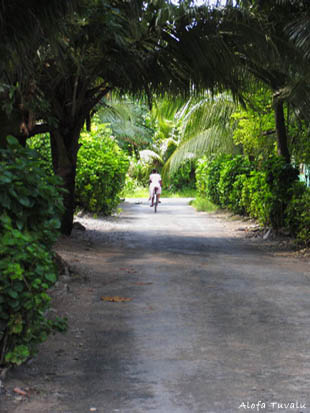 To make Tuvalu a model of an environmentally respectful nation means working and coordinating with each of the main areas listed below toward increased natural conservation, sustainable development, and harmony with the local ecosystem. To make Tuvalu a model of an environmentally respectful nation means working and coordinating with each of the main areas listed below toward increased natural conservation, sustainable development, and harmony with the local ecosystem.
The development of each of these areas of work will be done in parallel. Studies and implementation will require the participation of specialists and professionals in various fields. Resources will come from partners with a “natural fit”: international aid organizations, corporate underwriters and foundations The main areas of proposed intervention and some initial ideas are presented below.
Excluding the larger global issue of sea-level rise, based on observation and preliminary discussion with local residents, the areas of intervention, in order of importance, are as follows:
Drinking water/water for cleaning
- Storage and management of rainwater
- Reexamine system of desalination
- Study new methods of water purification such as UV purification
- Example: using seawater and “grey” wastewater for modern flush toilets, or dry compost toilet.
Waste products
- Clean up of non-officially designated landfills, most specifically the “Borrow-Pits”. This program can become a project federating the community
- Negotiate with foreign exporters for the return of packing materials
- Application of the 3R’s motto: REDUCE, RE-USE, RECYCLE
- More intense selective sorting (for the moment: compost and cans)
- Use of methane from waste and manure generated from pigs.
- According responsibility to visitors through taxation or duty to leave with waste generated (mainly plastic which does not weigh much and is easily compacted)
- landfill of remaining waste in official government-sanctioned and maintained areas + creation of an additional official landfill to serve southern end of Funafuti
Energy
The goal is to maximize use of local resources while minimizing life-cycle cost.
Four types of alternative energy are available on the archipelago. Combined they can supply electricity to the islands, moving Tuvalu toward energy self-sufficiency :
- Solar (photovoltaic)
- Wind (one wind generator per island, two for the main island)
- Biodiesel from coconut Copra
- Methane from waste and pigs.
- Conservation measures on the existing buildings such as more energy-efficient building design
- More efficient and regular mass transport
NOTE: the two main buildings, (hospital and government building), were built since 2001 by Japan and Australia with little environmental vision: not one solar photocell to make use of the principal energy available on Tuvalu: the sun.
NOTE 2 : A micro model is being designed to allow Tuvalluans to learn hands on how to use and maintain RET’s.
Air
- Replace fuel generators sustaining the island with engine running locally produced biodiesel
- Replace motorized vehicles with solar or hybrid vehicles
- Limit the number of vehicles per number of family/tribe members
- Implement a bus shuttle system, on demand, similar to taxis
- Partially subsidize the cost of existing taxis and buses
- Replace gas-powered scooters and motorbikes with electric, increase use of bicycles (rarely used even though the main island is no longer than 14 kilometers and the population and all services are within 5 to 6 kilometers).
Erosion
- Reconstitute and rehabilitate the affected shorelines
- Study adaptable types of erosion-resistant vegetation.
Note: Tuvaluans recognize that the number of inhabitants and thus the number of houses is reaching a maximum on the main island. It may be advisable to recommend a moratorium on new home construction except for replacing existing older houses. New construction would have to meet stricter technical and environmental standards (i.e. natural ventilation, insulation, cooling by water as opposed to air-conditioning, individual solar units, energy efficient lighting and appliances, etc).


 Simultaneously with the “model” program, a second aspect of the Small is Beautiful project is to address the larger problem of sea-level rise by: Simultaneously with the “model” program, a second aspect of the Small is Beautiful project is to address the larger problem of sea-level rise by:
1)developing a workable local, on-site solutions to rising sea and water levels 2)developing a sound plan for the eventual evacuation of Tuvalu and the creation of a new homeland.
The idea is to study existing solutions and to imagine new ways of adapting to rising sea levels and harsher weather conditions. One inhabitant proposed a “half-filled” seawall. Holland builds “amphibious” houses. German islanders build artificial hills and keep dry behind walls and doors with effective sealing.
The other aspect is to envision solutions in case of danger of immediate seawater inundation. For example: make available 2 cruise ships where the 5000 inhabitants of the two main islands could find shelter.
Any adaptation solutions would be greatly helped by the filling of the “borrow-pits” where the earth, “borrowed” in 1942 by the United Kingdom and the United States to build their airstrip, was never replaced. This could help in reducing ground flooding and would avoid illegal landfills in holes where nothing can be built or cultivated.
If, in spite of all efforts, climatic evacuation and exile for Tuvalu’s people proves to be unavoidable, we want to be able to propose solutions for a new homeland which would permit the nation’s culture and society to go on and which would approximate Tuvalu’s geography as closely as possible: 26 km2, on several islands with open ocean and lagoons. (Fishing, in one form or another, is integrated to Tuvalu lifestyle.) As an example: some years ago a few families from one of the microscopic islands of the archipelago, Vaitupu, bought another miniscule Fijian Island, Kioa. One option could be to sustainably develop Kioa to welcome the Tuvaluan population. To implement it, however, would require capital and other forms of humanitarian aid not currently available to the government.
At present, under an emigration program (Pacific Access Category) with New Zealand, up to 75 Tuvaluans are allowed into the country. Though a similar program has been requested of it, Australia (a non-signatory of the Kyoto protocol), has thus far refused to instate such a program.


 Nearly all forms of media (tv, radio, written press, photography, internet) are already represented among the first supporters of the project, and their support was expressed prior to our 2nd trip. Nearly all forms of media (tv, radio, written press, photography, internet) are already represented among the first supporters of the project, and their support was expressed prior to our 2nd trip.
Each trip (november/December 2004, summer 2006, Spring 2006) has been filmed, and so will all other steps of the program implementation, The pictures will be made available regularly to the media. Almost like a reality-documentary evolving in real time over many years. Due to its remoteness, images of Tuvalu are still rare and therefore images of the project have more chances to be widely aired than an identical project on another territory (for example they were shown early February 2005 on TF1 news, the biggest French network).
As an integral part of the project, activities and events are being organized with various media, organizations, institutions, to introduce and acquaint the general public with Tuvaluan culture, with music being the primary vector. The few traditional handcrafted creations (made of banana leaves, oils and other creams), will be further developed on-site using, one or two symbolic creations, designed by recognized international artists. The products will be distributed according to fair trade directives as an additional way of publicizing Tuvalu’s situation as well as a means of earning complementary income.

AWARENESS OF THE TUVALUAN POPULATION
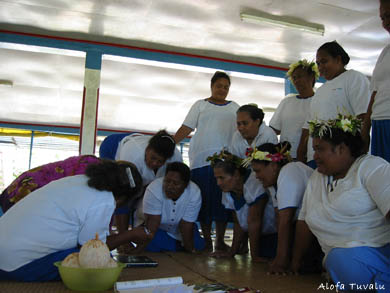 The awareness of the Tuvaluan people is a critical key to the success of “Small is Beautiful”. The trip allowing us to gauge interest and support amongst the population, as well as their willingness to actively participate – was a real success. Mission accomplished, the Tuvaluans clearly are supporting the project. The awareness of the Tuvaluan people is a critical key to the success of “Small is Beautiful”. The trip allowing us to gauge interest and support amongst the population, as well as their willingness to actively participate – was a real success. Mission accomplished, the Tuvaluans clearly are supporting the project.
A renewable energy micro model will be implemented in 2006 for them to learn about what they are going to be using and to become technically independant.
In reality, the challenge of convincing the 11,000 citizens of Tuvalu to modify their daily habits into more environmentally aware ones seems easier than mobilizing millions of Europeans for Earth Day 1990, a previous large-scale project spearheaded successfully by the creator of “Small is Beautiful”. This does not mean that the project will be implemented rapidly. The remoteness, the requirements of capital and other resources and the Tuvaluan way of life itself must be taken into account. The on-site project as outlined above is expected to require no less than ten years.
Modern industrial societies have long been losing their contact with nature. For their citizens, having to modify common habits, which have evolved, gradually, over centuries, into society-wide reflexes, will take much longer to achieve.
In Tuvalu, these behaviours have not yet become reflexes. Partly by necessity and partly by choice, the Tuvaluan people remain much closer to whatever nature they have left. In addition, plain common sense is a part of the national character.
Just a year ago, few Tuvaluans were conscious of the real and serious problems they were confronted with. Today, with more journalists and scientists having investigated the situation on site, many more citizens realize that one way or another, they will have to act.
Their present environmental awareness, with repeated environmental workshops over the last few years and across all segments of the population, is perhaps now more advanced than most “modern” societies.
In order to encourage and actualize positive environmental change in Tuvalu, we will convey the kind of environmentally conscious behaviors outlined in existing documents such as the “Fifty Simple Things”. These handbooks created for Earth Day 90, will be adapted to the specific local situation and in a manner that is understood by the local population.
On-site communication will be relayed by Tuvalu’s daily radio broadcasts and its local 4-page monthly magazine…and additionally via CD and DVD, which most of Tuvaluan households are already equipped with.
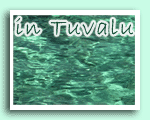 More important will be the local community institutions, notably the church of Tuvalu, which represents 97% of the population ; by the local group associations, Tango (Tuvalu Association of NGO’s ); and by simple word of mouth (a vital means of information exchange in small communities). The main island of Funafuti is a strip of land 11 kilometers long and often less than 50 meters wide, which facilitates mobility. Such a small landmass is an asset for disseminating information. It is also, unfortunately, the major reason for Tuvalu’s vulnerability. More important will be the local community institutions, notably the church of Tuvalu, which represents 97% of the population ; by the local group associations, Tango (Tuvalu Association of NGO’s ); and by simple word of mouth (a vital means of information exchange in small communities). The main island of Funafuti is a strip of land 11 kilometers long and often less than 50 meters wide, which facilitates mobility. Such a small landmass is an asset for disseminating information. It is also, unfortunately, the major reason for Tuvalu’s vulnerability.
CAMPAIGN IN FRANCE
The issues around global warming are very much into people’s mind and many actions are being taken by NGO and institutions to bring awareness. We will of course support all these initiatives.
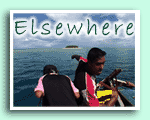 The film “Trouble in paradise” is still being shown in festivals in many places in the world. We are also spreading information about our action via regular presence to Climate manifestations, and mailings to NGO’s and media on a large scale: subjects were aired on TF1, F3 and F2, national evening news as well as on several news cables from October 2004 to this day, showing extracts of the film and new pictures of flooding in Tuvalu. The film “Trouble in paradise” is still being shown in festivals in many places in the world. We are also spreading information about our action via regular presence to Climate manifestations, and mailings to NGO’s and media on a large scale: subjects were aired on TF1, F3 and F2, national evening news as well as on several news cables from October 2004 to this day, showing extracts of the film and new pictures of flooding in Tuvalu.
More than this, our main action in France concerns first grade children.

|